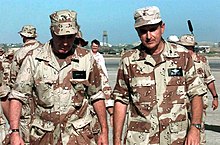Unified Task Force
The Unified Task Force (abbreviated UNITAF , German for "united operations association") was a mission supported by the United Nations with the aim of stabilizing Somalia , which was affected by civil war and famine . UNITAF was led by the USA , but several other countries also participated. The mission lasted from December 1992 to May 1993, when he was replaced by the UNOSOM II mission .
background
Since the situation in Somalia had gotten completely out of hand and there was no longer any state power that could maintain civil order, the United Nations decided in April 1992 to launch the UNOSOM I mission . Due to the fierce fighting between warring clans and warlords, the mission was doomed to failure, as the warring parties also tried to forcibly seize the aid supplies in order to supply their militias .
In the last quarter of 1992 the situation deteriorated further: various warring parties split into smaller and smaller factions of individual leaders. Food distribution agreements with one party were useless if another party over whose territory the aid was to be transported did not recognize it. Many clans were hostile to UNOSOM I: UN troops were shot at, supply ships were attacked and the runway at Mogadishu airport was often the target of mortar fire . In addition, the offices and warehouses of the aid organizations were often attacked and looted. Meanwhile, hundreds of Somalis were starving to death every day.
In November 1992, the clan leader Mohammed Farah Aidid had become so powerful in the capital that he called on the UN to withdraw and threatened further UN operations with open violence.
Due to increased public pressure, the UN Secretary General Boutros Boutros-Ghali recommended the use of heavily armed troops to pacify the clans. Chapter VII of the UN Charter allows the use of armed forces to restore international security and peace. It was the first time this provision was applied. Due to the expected scope of the mission, it was assumed that the UNOSOM would not be able to coordinate and direct this operation. It was therefore decided to place the operation under the command of the member states in order to pave the way for further peace missions.
On December 3, 1992, the deployment was decided by Security Council Resolution 794 .
USA participation
Resolution 794 was not specifically addressed to the United States. However, they had already offered the UN larger contingents of troops in order to restore peace in Somalia. On December 4, 1992, US President George Bush announced in a speech to the nation that US troops would be sent to Somalia. In the USA the operation was called Operation Restore Hope , formally UNITAF . UNOSOM I has officially ended. On December 9, 1992, the first troops landed on the Somali coast amid great media hype.

Composition of the force
The majority of the troops were provided by the USA (25,000 out of a total of 30,000 soldiers). Other countries involved included Germany , Great Britain , Australia , Canada , Morocco , Italy , Norway , Spain , Greece and India .
The armed forces were led by the US Central Command . However, there were some disagreements between the troops, for example the Italians used local militias to keep the peace, while the French Foreign Legion was accused of being too harsh with the population and in disarming the militias.
trouble
The main aim of UNITAF was to disarm the militias and gangs. The US believed that this was an impossible task. However, the UN stated that when militias had so many heavy weapons, peace would not be possible. The UN Secretary General had a secret agreement with the US that disarming the militias would remain the long-term goal, although the White House publicly called for another mission for this task. This contradiction between disarmament and violent peacekeeping would later lead to problems at UNOSOM II.
development
UNITAF was only ever planned as a transition mission. As soon as peace is restored, another UNOSOM mission should begin. On March 3, 1993, the Secretary General recommended to the UN Security Council that UNITAF be transformed into UNOSOM II . However, he noted that despite the strength of UNITAF troops, the peace had not yet been fully restored and that there was still no government and no police.
He therefore recommended giving UNOSOM II a strong mandate to secure peace and help Somalis to build a new government by striving for a democratic Somalia.
As a result, UNITAF was officially terminated on May 4, 1993 and replaced by the UNOSOM II mission, which was brought into being by resolution 837 .
Web links
- UN Department of Peacekeeping: UNOSOM 1
- UN Department of Peacekeeping: UNOSOM 2
- Nils Goede: The Intervention of the United Nations in Somalia. An analysis of the decision-making processes in the Security Council for Resolution 794 . (PDF; 821 kB) INEF report No. 98, 2009 Duisburg.
